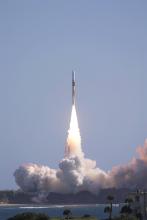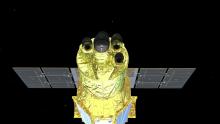XRISM, a Japanese X-ray telescope scheduled for launch as early as this month, stares into space in this artist's concept. The telescope will study black holes, neutron stars, the remnants of exploded stars, and other powerful objects and events. [NASA/GSFC/Conceptual Image Lab]
You are here
XRISM
The environment around a black hole is a maelstrom of superhot gas. Most of the gas funnels into the black hole, but some escapes in “jets” that fire out at almost the speed of light. The gas gets so hot that it shines mostly in X-rays. So to fully understand what’s going on around a black hole, we need to observe its X-rays. But Earth’s atmosphere absorbs X-rays, so we have to send telescopes into space to see them.
Japan is ready to do just that. It’s scheduled to launch an X-ray telescope called XRISM within the next few weeks.
Even from space, it’s not easy to catch X-rays — they zip into and even through normal mirrors. So X-ray telescopes consist of a set of concentric tubes that are coated in gold. X-rays skip off the surfaces of the tubes, like stones skipping off a pond, and into special detectors.
XRISM’s instruments will study many powerful objects and events. They’ll look at ribbons of hot gas inside galaxy clusters, for example. The temperature and speed of the gas helps astronomers understand the cluster’s birth and evolution.
XRISM also will study the chemical evolution of the universe — how different elements formed and were scattered through space. That will help us understand how and when the first stars were born, how the stars created new elements, and how those elements were incorporated into later generations of stars.
XRISM will share its ride to space with a mission to the Moon; more about that tomorrow.
Script by Damond Benningfield
Get Premium Audio
Listen to today's episode of StarDate on the web the same day it airs in high-quality streaming audio without any extra ads or announcements. Choose a $8 one-month pass, or listen every day for a year for just $30.







